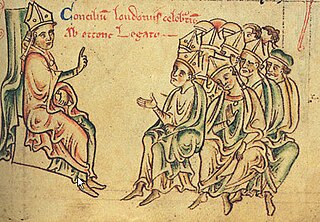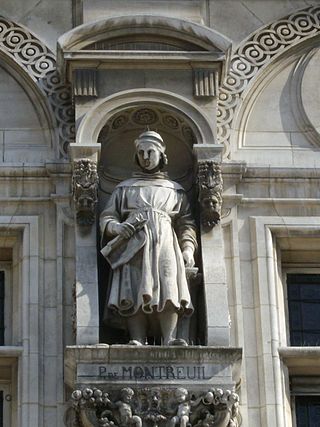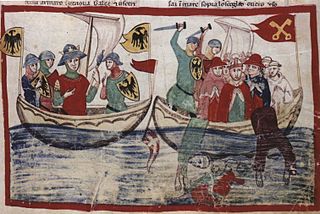| 1220s .1230s in architecture. 1240s |
| Architecture timeline |
This is a list of events related to architecture in the 1230s.
| 1220s .1230s in architecture. 1240s |
| Architecture timeline |
This is a list of events related to architecture in the 1230s.

Year 1165 (MCLXV) was a common year starting on Friday of the Julian calendar.

Heraklion or Herakleion, sometimes Iraklion, is the largest city and the administrative capital of the island of Crete and capital of Heraklion regional unit. It is the fourth largest city in Greece with a municipal population of 179,302 (2021) and 211,370 in its wider metropolitan area, according to the 2011 census.

The Château d'Angers is a castle in the city of Angers in the Loire Valley, in the département of Maine-et-Loire, in France. Founded in the 9th century by the Counts of Anjou, it was expanded to its current size in the 13th century. It is located overhanging the River Maine. It is a listed historical monument since 1875. Now open to the public, the Château d'Angers is home of the Apocalypse Tapestry.

The Dilwara Temples or Delvada Temples are a group of Śvētāmbara Jain temples located about 2+1⁄2 kilometres from the Mount Abu settlement in Sirohi District, Rajasthan's only hill station. The earliest were built by Bhima I and supposedly designed or at least financed by Vastupala, Jain minister of Dholka. They date between the 11th and 16th centuries, forming some of the most famous monuments in the style of Māru-Gurjara architecture, famous for their use of a very pure white marble and intricate marble carvings. They are managed by Seth Shri Kalyanji Anandji Pedhi, Sirohi and are a pilgrimage place for Jains, and a significant general tourist attraction. The Dilwara temples are regarded as the most impressive among Jain temples in Rajasthan.

Maria Laskarina was a Greek Queen consort of Hungary by marriage to Béla IV of Hungary. She was the daughter of Theodore I Laskaris and Anna Komnena Angelina.

A Jain temple, Derasar or Basadi is the place of worship for Jains, the followers of Jainism. Jain architecture is essentially restricted to temples and monasteries, and Jain buildings generally reflect the prevailing style of the place and time they were built.

The Church of Saint-Nizier is a church in the Presqu'île district of Lyon, France, in the 2nd arrondissement, between the Place des Terreaux and the Place des Jacobins. Its name refers to Nicetius of Lyon, a bishop of the city during the 6th century. Begun in the 14th century and only completed in the 19th century, the church contains a variety of architectural styles, ranging from the neo-Gothic spire to the classical Renaissance facade. In 1998, it was inscribed on the UNESCO World Heritage List along with other historic buildings in Lyon.

Gothic architecture appeared in the prosperous independent city-states of Italy in the 12th century, at the same time as it appeared in Northern Europe. In fact, unlike in other regions of Europe, it did not replace Romanesque architecture, and Italian architects were not very influenced by it. However, each city developed its own particular variations of the style.

French Gothic architecture is an architectural style which emerged in France in 1140, and was dominant until the mid-16th century. The most notable examples are the great Gothic cathedrals of France, including Notre-Dame Cathedral, Reims Cathedral, Chartres Cathedral, and Amiens Cathedral. Its main characteristics are verticality, or height, and the use of the rib vault and flying buttresses and other architectural innovations to distribute the weight of the stone structures to supports on the outside, allowing unprecedented height and volume. The new techniques also permitted the addition of larger windows, including enormous stained glass windows, which fill the cathedrals with light.
Ralph of Maidstone was a medieval Bishop of Hereford.

Otto of Tonengo was an Italian papal diplomat and cardinal, first as deacon of San Nicola in Carcere from 1227 and then as bishop of Porto e Santa Rufina from 1244.

Pierre de Montreuil was a French architect. The name formerly given to him by architectural historians, Peter of Montereau, is a misnomer. It was based on his tombstone inscription Musterolo natus, a place name that was mistakenly identified as Montereau rather than Montreuil.

Jain art refers to religious works of art associated with Jainism. Even though Jainism has spread only in some parts of India, it has made a significant contribution to Indian art and architecture.
The following is a timeline of the history of the city of Pisa in the Tuscany region of Italy.

Māru-Gurjara architecture or Solaṅkī style, is the style of West Indian temple architecture that originated in Gujarat and Rajasthan from the 11th to 13th centuries, under the Chaulukya dynasty. Although originating as a regional style in Hindu temple architecture, it became especially popular in Jain temples, and mainly under Jain patronage later spread across India, then later to diaspora communities around the world.
Vastupāla was a prime minister of the Vāghelā king Vīradhavala and his successor Vīsaladeva, who ruled in what is now the Gujarat region of India, in the early 13th century. Although he served in an administrative and military capacity, he was also a patron of art, literature and public works. He, together with his brother Tejapāla, assisted in the restoration of peace in the kingdom, and served in a number of campaigns against Lāṭa, Godraha, Kutch and the Delhi Sultanate. The brothers were instrumental in the construction of the Luniga-vasahi temple on Mount Abu and the Vastupala-vihara on Girnar.

James of Pecorara or Giacomo da Pecorara was an Italian monk, cardinal and diplomat.
Henry of Morra was a nobleman, judicial official and sometime regent of the Kingdom of Sicily, which at the time covered both the island of Sicily and the mainland southern Italy. As master justiciar of the Magna Curia from 1223 until his death, he was the most prominent official in the Sicilian court of Frederick II, King of Sicily and Holy Roman Emperor.